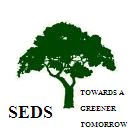 Peasant farming by smallholders is the most sustainable and non-polluting way of life. Unfortunately the manner in which peasants traditionally tilled their fields does not work any longer. Cultivating small holdings is now an annual gamble. In order to help these people SEDS started with a sustainable agriculture (SA) programme (http://sedsngo.blogspot.com/2010/04/sustainable-agriculture-lead-farmers.html).
Peasant farming by smallholders is the most sustainable and non-polluting way of life. Unfortunately the manner in which peasants traditionally tilled their fields does not work any longer. Cultivating small holdings is now an annual gamble. In order to help these people SEDS started with a sustainable agriculture (SA) programme (http://sedsngo.blogspot.com/2010/04/sustainable-agriculture-lead-farmers.html). 
But glorifying the peasant lifestyle with clichés alone will not work. Small and marginal farmers will not agree to stay impoverished forever. They are lured by quick and easy returns. Mainstream cultivation, with high external inputs offers them a green dream but it ends in a nightmare. Over usage of chemical fertilizers and pesticides turns the soil into a lifeless medium. Annually farmers are forced to increase the inputs if they want to keep up the soil fertility leading to pauperisation and acute farmer distress. Mechanisms of the carbon market present a solid solution to this impending crisis by leveraging resources.
We started with a project called Low Carbon Farming (LCF) (http://sedsngo.blogspot.com/2010/01/low-carbon-farming.html). Simply stated, sustainable agriculture + carbon credits = LCF. By adopting SA practices farmers reduce the output of their green house gasses. These reductions can be quantified and sold on the carbon market.
LCF involves a basket of practices that reduce/minimize/remove use of synthetic fertilizers (methane avoidance and N2O reduction) while, at the same time, improving soil carbon. This is done through reduced tillage, precision fertilization, anaerobic composting, organic fertilizers, mulching, intercropping, multi-cropping, irrigation efficiency and a horde of techniques specially designed for particular regions and communities.
In collaboration with FCN we provide them the methodology to achieve this. Complex science is broken down into simple linked tasks. Staff visits the farmers and records demographic and land data.
For this we even go to the fields and record the plots with GPS so we get correct positions and figures of their landholdings. Walking around the circumference of the plot we register each corner point and create a two dimensional picture of the field.





This is necessary to calculate the emission reductions the farmers will get by applying SA practices. The emission reductions of the practices are scientifically measured by a science team. Samples of soil, farm yard manure together with the knowledge of the emissions of chemical fertilizers will give us a precise picture of the reduced green house gases. In the end we will execute carbon contracts which each farmer individually.
Carbon revenues will be the incentive, and show the way for small and marginal farmers to reverse and restore the damage done to their lives, livelihoods and the environment and also receive an income for these practices from carbon buyers.




